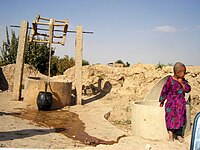
Photo from wikipedia
Imaging hydraulically active fracture zones (HAFZ) is of paramount importance to subsurface resource extraction, geologic storage, and hazardous waste disposal. We have developed advanced 3D finite-element (FE) electrical imaging algorithms… Click to show full abstract
Imaging hydraulically active fracture zones (HAFZ) is of paramount importance to subsurface resource extraction, geologic storage, and hazardous waste disposal. We have developed advanced 3D finite-element (FE) electrical imaging algorithms for HAFZ in the presence of a steel-cased well. The algorithms use tetrahedral FE meshes in the simulation domain and coarse rectangular finite-difference meshes in the imaging domain. This heterogeneous dual-mesh approach is well suited to modeling the multiscale earth model due to steel-cased wells. We find that the algorithms accurately and efficiently simulate surface electric field measurements over a 3D HAFZ at depth when one end point of a surface electric source is connected to a wellhead. For brevity, this configuration is called the top-casing electric source method. By replacing a hollow cased well with a solid prism, we improve our computational efficiency without affecting the solution accuracy. The sensitivity of the top-casing source method to HAFZ highly depends on the continuity of a steel-cased well because it makes currents preferentially flow to HAFZ. The sensitivity also depends on conductivity structures around the well because they control current leaking from the steel-cased well. We find that the method can image a localized HAFZ and detect changes in its width and height. The imaging results are improved when a volume of the imaging domain is constrained from geomechanical perspectives. A primary advantage of the method is the fact that the sources and receivers are placed on the surface, thus not interrupting the well operation.
Journal Title: GEOPHYSICS
Year Published: 2019
Link to full text (if available)
Share on Social Media: Sign Up to like & get
recommendations!